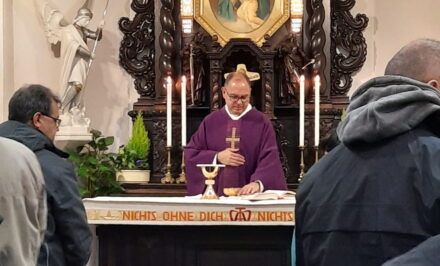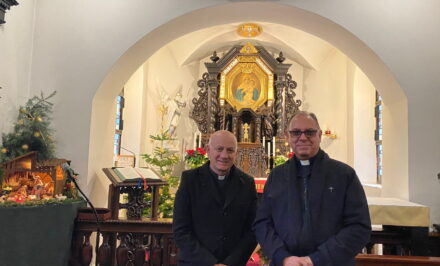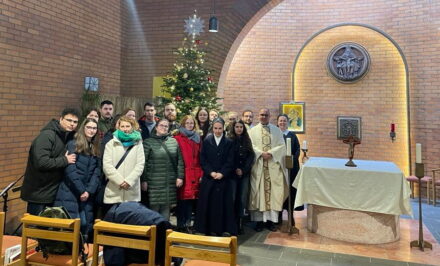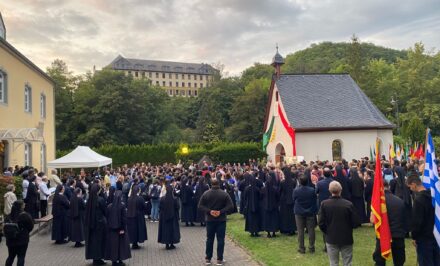 Agathe Hug. It is obvious – if we were to ask which is the most important date in December for the Original Shrine, most Schoenstatters would probably reply: The Miracle of the Holy Night in 1965, of course! Our Father and Founder had returned on Christmas Eve to the place where his life’s work had started. After this night he never entered the Original Shrine again. He was brought back in his coffin. We might be tempted to reflect on how bad, sad and painful it was for him. We would have to calculate, however, that he was independent of space and time as he lived and worked constantly in the presence of God and the Blessed Mother. And if we believe that the same streams of grace flow out from daughter shrines as from the Original Shrine …
Agathe Hug. It is obvious – if we were to ask which is the most important date in December for the Original Shrine, most Schoenstatters would probably reply: The Miracle of the Holy Night in 1965, of course! Our Father and Founder had returned on Christmas Eve to the place where his life’s work had started. After this night he never entered the Original Shrine again. He was brought back in his coffin. We might be tempted to reflect on how bad, sad and painful it was for him. We would have to calculate, however, that he was independent of space and time as he lived and worked constantly in the presence of God and the Blessed Mother. And if we believe that the same streams of grace flow out from daughter shrines as from the Original Shrine …
 Nevertheless the Original Shrine is incontestably a very special place and it is a grace if you can always be close to it and are able to visit it at any time and whenever you wish. The Original Shrine, in particular, reminds us of the many people who offered up their lives here throughout the years, and that some of these oblations were accepted.
Nevertheless the Original Shrine is incontestably a very special place and it is a grace if you can always be close to it and are able to visit it at any time and whenever you wish. The Original Shrine, in particular, reminds us of the many people who offered up their lives here throughout the years, and that some of these oblations were accepted.
The first photo shows the Original Shrine at Christmas 1927. The occasion for the photo was the fact that the Founder had celebrated Midnight Mass here for the first time with the young community of Sisters of Mary. The photo was taken on 13 January 1928.
Father Kentenich at the Original Shrine
 The second photo does not show our Founder’s return in 1965, but his return on 20 May 1945 from the concentration camp at Dachau. This is probably the first photo that shows Fr Kentenich in the shrine. He is accompanied by Fr Heinz Dresbach on the left and Fr Josef Fischer on the right.
The second photo does not show our Founder’s return in 1965, but his return on 20 May 1945 from the concentration camp at Dachau. This is probably the first photo that shows Fr Kentenich in the shrine. He is accompanied by Fr Heinz Dresbach on the left and Fr Josef Fischer on the right.
In the chronology of the Original Shrine we read:
1 December 1954
The frame around the MTA picture is gilded with genuine gold by the Women’s Federation.
8 December 1914
Seventeen members of the Marian Sodality make their consecration in the chapel. Among them was Max Brunner. At the same time 22 students founded the Congregatio Minor, the junior Sodality, through their consecration. It accepted the students in the middle section of the College. In his thanksgiving speech in the study room Max Brunner addressed the statue of Mary Immaculate with the famous words: Ave imperatrix, morituri te salutant (Hail, Empress, those who are about to die salute you!). He had already received his call up papers to fight in World War I.
15 December 1935
The Heroes’ Graves was given a new look and a big stone was put up for Joseph Engling (Engling Stone with hanging lamp).
23 December 1919
After his term of office as Provincial Superior had come to an end, Fr Kolb moved to Schoenstatt, and was commissioned by the Movement Leader, Fr Kentenich, to look after the shrine.
Christmas 1916
A Christmas Crib is placed in the shrine. Fr Kolb, Provincial Superior, donated the figures.
24 December 1929
Start of perpetual Exposition of the Blessed Sacrament and Adoration in the shrine (at night in the house chapel of the Old House).
24 December 1965
Our Father and Founder knelt in the Original Shrine after 14 years of exile, and celebrated Midnight Mass. After this he never entered the shrine again until his death.
25 December 1919
First Holy Mass in the shrine after it had been renovated.
From 1434-28 December 1436
Church interdict of the Cloister at Schoenstatt.
Old Year’s Night 1940/41
The young men (with Heinz Schäfer) light a new Sanctuary Lamp shaped like an orb.
The history of Old and New Schoenstatt has witnessed many ups and downs. Canonisable saints grew there, but guilt and failure were not unknown. The 800 years of the cloister’s history was commemorated in 1943. Fr Kentenich, who was in Dachau, called for reparation to be made for all the sins committed in the course of the long history of this place.
A brochure on the history of Old Schoenstatt, Das alte Kloster am Rhein (The ancient cloister on the Rhine) by Dr Andreas Kohl, a Pallottine Father, published by the Pallottines in 1903 gives an account of the Church interdict:
Unfortunately in 1434 the cloister was put under Church interdict. After the death of Archbishop Otto von Ziegenhayn (1418-1430), the electors were divided about whom to elect as his successor. The majority elected the Trier Canon Jakobus von Girk, later to become Archbishop, while the minority, which was more powerful, appointed the Cologne Deacon Ulrich von Manderscheid. Since they could not agree on the matter, Pope Martin V (1417-1431) appointed the elderly Bishop of Speyer, Raban von Helmstadt (1430-1439) as Archbishop of Trier. The Schoenstatt nuns, however, had wanted Ulrich von Manderscheid, and like others were not prepared to give up their obstinate stand. For this they came under the bann. Only in 1436 did Bishop Friedrich von Worms receive the authority to free the cloister from the bann. The nuns were absolved in Koblenz on 28 December that year.
It isn’t necessary to go to such lengths, but greater and lesser faults and failings have happened also in the time of New Schoenstatt. In view of the centenary in 2014 we can be sure that our Father and Founder would repeat his appeal of 1943.
See also: www.urheiligtum.de
Translation: Mary Cole, Manchester, England













